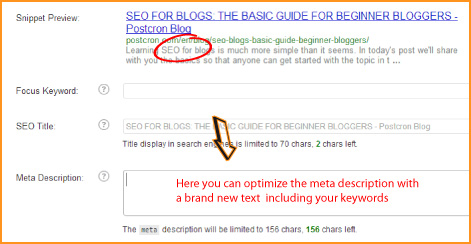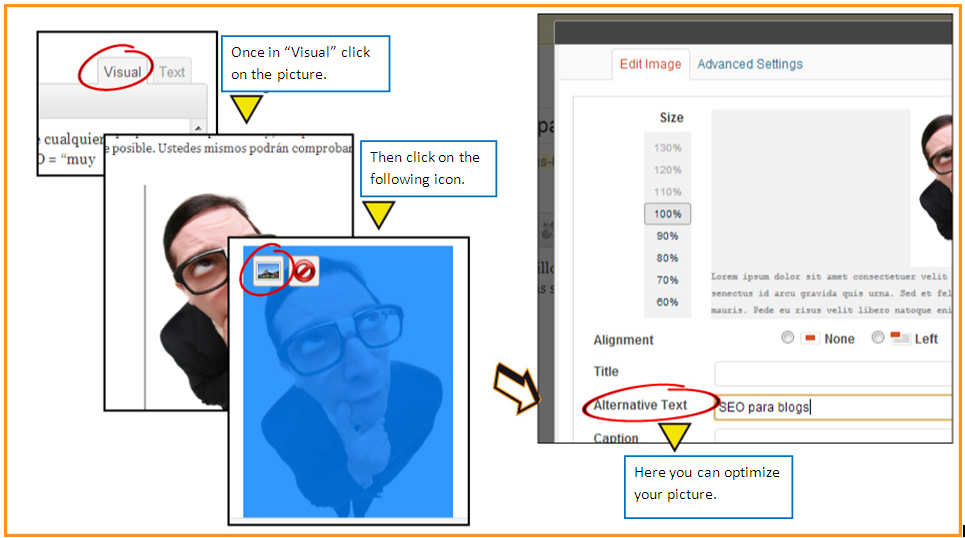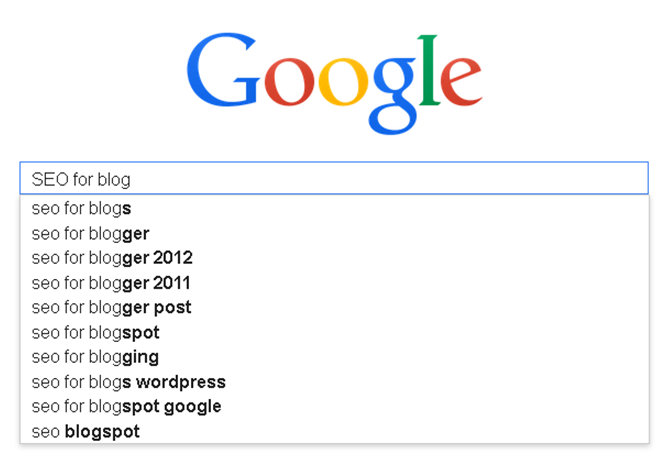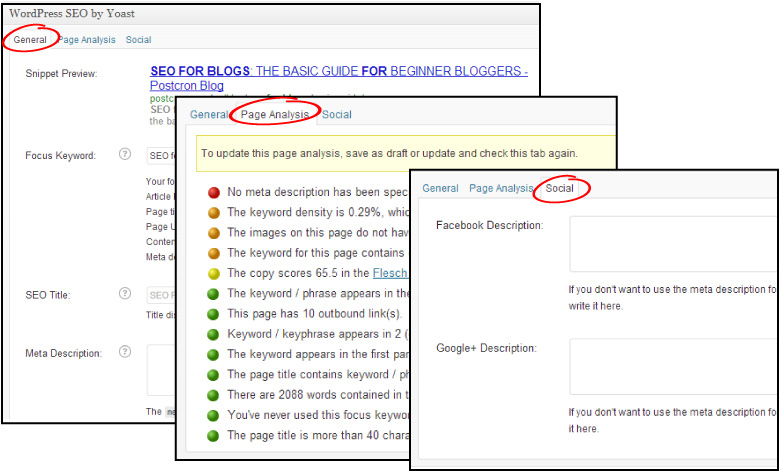Learning SEO for blogs is much simpler than it seems. In today’s post we’re gonna provide you with the basics in the simplest way possible. so that each and everyone of you can get started on it right away. You’ll see that the myth (SEO = “very complicated”) is just that, a myth.. Okay, Let’s get started!

My story about the “SEO for blogs myth”:
To be honest, when I started with Postcron’s blog I didn’t know a lot about the “theory”or how to come up with it, optimize it or even take it to the next level. I only knew I love to write, convey knowledge, and help other people with their projects and businesses.
So, when the day came that I had to start researching/studying about SEO for bloggers, there was tons of information, words, and structures. Although they aren’t really that complicated, they were explained or written in a really complicated way, which lead me to feel this way: 

After going through the mountain of information (which I DID go through) I internalized and learned a little (since I’m still learning). So, I thought I’d write a basic guide of SEO for blogs in the simplest, most friendly way possible, ideal for those like me, who know very little if anything about SEO. What it is, what it’s for, and how to apply it to a blog is everything we’re going to cover in this post.
WHAT DOES SEO MEAN?
SEO means: Search Engine Optimization.
I must admit that some years ago the first time I heard that word I wasn’t sure if they were talking about the CEO of a company or what… Really. I had no idea what SEO for blogs was.
I must admit that some years ago the first time I heard that word I wasn’t sure if they were talking about the CEO of a company or what… Really. I had no idea what SEO for blogs was.
HOW DOES IT WORK?

Summing up, knowing about SEO allows us to optimize our articles and actually have a chance to be the 1st spot on the list instead of the 26th.
WHY should we learn and study SEO for blogs?
Why learn about it? So you can get the #1 spot on the results list of the search engine.

- 1-That you’re excellent at writing and that people think your content is valuable. This gives you a lot of authority, popularity and among other things, makes you feel that the hatd work and determination you put in, is worthwhile. Leaving the sentimental aspect aside… let’s move on to the second reason:
- 2-That you can make (a lot) more money. It’s cold but it’s true. If you’re in the first spot or even close you’ve got a hell of a lot more chances of people clicking on your link. This means more traffic, more prospective clients, sales, subscribers, advertising, sponsors, etc, etc, etc, etc, etc, etc.
SEO’S STRUCTURE: ON – OFF
WHAT’S ON-PAGE OPTIMIZATION?
It’s everything you can do ON your page or IN your article in order to optimize it and get those spiders to find and analyze your content. It’s basically how you get the search engine to rank your article higher on the results listrelated to the topic or keyword of your post.WHAT’S OFF-PAGE OPTIMIZATION?
All of those external factors that influence the positioning of your article:popularity within social networks (how much it’s shared and/or commented on), if other sites have links to your articles, and so on. There are many factors (which we’ll develop throughout the article). The search engine considers all of this information, and measures the relevance and quality of the content and then ultimately decides if it’s worth showing the user or not.
WHAT TO OPTIMIZE WITHIN YOUR BLOG AND HOW TO DO SO
“ON-PAGE”
KEYWORDS:
These are the basis for the ON-page optimization of your article. That’s why it’s so important you use them in a clever way so spiders will find you and will be able to show you to the world. Otherwise, you can have excellent content, be an outstanding writer but if you are not discovered, what’s the point?
About the usage of keywords in the text, MOZ is one of the companies with more authority on the subject. In its basic guide for beginners they suggest the following checklist to know where and how many times to include keywords in an article. After this checklist, we’ll explain each point in more detail:
- At least once in the main title (H1).
- At least in one or two headings.
- At least 3 times in the body of the article.
- At least once in “bold” and “italics”.
- At least once in the “Alt” of a picture (below we’ll show you how to do it and why).
- Once in the URL.
- At least once in the Meta description.
In more detail, WHERE…
URL:
It’s important your URL isn’t too long or else spiders might render it as spam. So, it’s best if you keep it short and include the keywords. You can also edit it if your original title was long. Take a look at my example:
TITLE:
It’s the first place the algorithm analyzes, so you gotta inlude your keyword there. It’s recommended to avoid going over 70 characters (including spaces)in a title since that’s the amount of characters the engine shows in the results. This also has to do with Twitter, since we need to leave enough space to share the link without making it shorter. On the web there’s a lot of info for learninghow to write optimized titles.
HEADINGS:
The second place spiders analyse are headings, H2, 3, 4, (etc) or however you’d like to call them. We recommend using H2 in these cases since they are the ones that hold more value. By the way, it’s recommended to place the keyword in each of them. It’s not necessary to include the keyword in each one because it’ll seem unnatural.
BODY:
We suggest inluding the keyword 3 times. You can use it a few more times, as long as it doesn’t look artificial and the length of the text allows for it. A high density of keywords in a text can actually be a negative factor for Google, and cause them to categorize the article as low quality. Keep in mind, even more than keywords, the most important thing in SEO for blogs, is your blog. Your best strategy is the content, what you write. If it’s high quality, original, has good pictures, videos and links that provide appropriate extra information for your audience, the rest of the actions you perform around it will truly optimize it.
META DESCRIPTION:
Okay, so, the tag in the meta description isn’t in fact a ranking factor for the algorithm but it’s the text the engine shows the user in the search results, which is why it should be attractive. From your blog’s administration screen you can modify them to include your keywords as well.
ALT TEXT IN PICTURES:
Pictures are another element you can optimize. Their names should be related to the keyword or the topic so that they show up in the results for image searches. This makes them another source you can use to direct traffic to your blog. Instead of using “aksdbaksjdba254684.jpg” include a good short description related to your topic, not the topic itself (right?). It’s no good using: “basisandfoundationofseoforbloggers.jpg”.- Besides putting a descriptive name to the file of the picture, the “Alt-text” or alternative text is the text browsers like (Chrome, Firefox, etc) show the user if for some reason they can’t show the picture. This alternative text is important for browsers because it’s an “alternative” to the picture. Take a look at how to define it in WordPress:
Summing up, we should make the spiders’ task easier so they can clearly identify what you are writing about, analyse it, and ultimately show YOUR article in the search results.
 There are several tools that you can use to confirm if the keyword you’ve selected is the one people use to find your content.
There are several tools that you can use to confirm if the keyword you’ve selected is the one people use to find your content.- For instance, the suggestions that Google gives you when you search for something. Utilize this tool to help you find out what the most common phrases searching for your topic are. For example:

- Google’s Keyword Planner: for those of you who have never used this tool here’s a “back to the basics” tutorial from Google so you can learn how to use it.
https://www.youtube.com/watch?v=IltpsVcxF9k
Ok, so I’ve covered the basics that you should take into account when developing “On page optimization”.
“OFF-PAGE”
Remember Off-page optimization refers to all those external factors that affect the positioning of your article.
- Backlinks: These are all of the pages that quote our article using a link; they are the external links that point to our article. When someone creates a link from outside (from another site/blog) pointing to our article they’re creating a backlink which benefits us since the more people quoting our article in their blogs or sites the more chances spiders will consider your content as relevant and it will carry more weight when positioning in the ranking. You’ll find there are a lot of packages being offered with “backlinks” to be bought, but please, avoid doing that. An excellent strategy to create backlinks in a natural way, is working with other colleagues and getting them to share your links in their articles and then you share their site or one of their posts. This way, not only do you create a community of your own but you also create a “chain of favors” that benefits both parties emensely.
 Another option for off site optimization is through “guest blogging”. You can participate in other blogs and, as long as it’s appropriate, include your site (through a link) or an article of yours if it adds information to the post you are writing as a guest. That way, you yourself create the backlinks.
Another option for off site optimization is through “guest blogging”. You can participate in other blogs and, as long as it’s appropriate, include your site (through a link) or an article of yours if it adds information to the post you are writing as a guest. That way, you yourself create the backlinks. - Share your articles in social networks. Not only will you generate more traffic towards your blog but spiders also look for those posts that have been shared many times, that have lots of comments and/or have been mentioned on various social networks. These are important factors when trying to influence your article’s position on the search engine results list.
Other aspects to take into consideration:
1-Choose a plataform that’s easy to use and one which you can apply SEO strategies. I personally recommend WordPress because it’s the easiest and most practical. Besides, it has sooooo many more plugins, widgets and apps compatible to WP than any other platform (which is ideal for beginners in the SEO world.) We use the plugin for SEO called “WordPress SEO by Yoast“. Below you’ll see how to see how good your SEO is directly from WP. On the admin screen, look underneath your article and check on the following aspects:

I hope you found this post useful and if I’ve left anything out of this basic guide that you consider important or would like to know how to do, please don’t hesitate to leave a comment so I can add it!
To view the original article Click Here

I can’t work with Yoast. I’m monitoring these kinds of posts so I can choose a different SEO plugin. Wondering if any other web content writers have tried using the INK for All applications? http://bit.ly/2XUjrhu
ReplyDelete